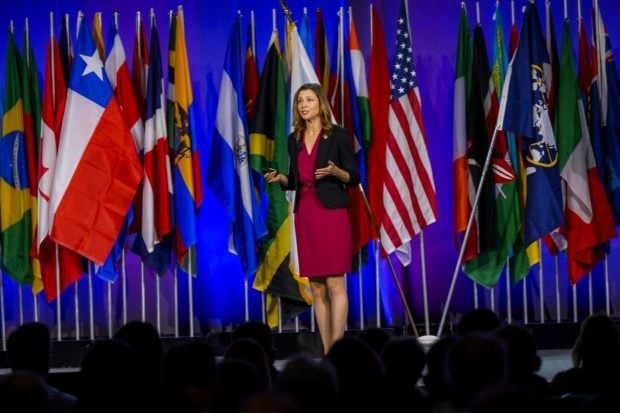Marvel is defined as something that causes wonder, admiration or amazement.
Considering that the average tenure of a credit union CEO is about 12 years, the CEO you are about to meet will make you wonder how she made it through 65 years of service. You'll be amazed how much she grew the credit union's assets and membership. And by the end of this story, you'll gain an admiration for a CEO who epitomized the credit union principles and made a difference.
Her name, suitably enough, is Marvel … Marvel Ebenhahn, the granddaughter of an 1883 homesteader and the daughter of a North Dakota farmer, who became the first manager in 1952 of a tiny credit union that served farmers when she was only 17 years old.

Recommended For You
On Jan. 1, Marvel sort of retired from the Community Credit Union in New Rockford, N.D. She plans to keep a lighter work schedule as a loan officer and serve as an advisor for the second president/CEO, Barb Messner, who started as a teller 35 years ago and worked her way up to operations manager.
"Sixty-five years ago, there probably weren't a lot of women holding a president's position in the financial world," Messner said. "She has seen many trends in the financial world. She has a wealth of knowledge, and she has a lot of advice. Marvel is very smart and she's been a mentor to me."
Because Marvel has been CEO for so long, she felt a gradual leadership transition process would help reassure members that the credit union will continue to be managed in the very capable hands of Messner.
"I've always believed that management with a little care is better than crisis management or preventive management," Marvel observed. "I've been here for a long time and people get used to you. Barb is very, very capable and she has an inside view of how the credit union operates. She's a hard worker and she is very intelligent. That combination is hard to beat."
Undoubtedly, Marvel has seen many things throughout her 65-year career, which enabled her to develop a down-to-earth leadership style that matched the rural community she served.
"Marvel has been a mentor and inspiration for many credit union leaders throughout the decades here in North Dakota," Jeff Olson, president/CEO of the Credit Union Association of the Dakotas, said. "Not only does she embody the cooperative spirit of putting members first, she really epitomizes our wonderful, traditional, 'small town' rural values of faith, family, community and hard work."
When Marvel began her credit union career six and a half decades ago, Community CU managed $18,000 in assets, about $160,000 in 2017 dollars and 250 members. Today, the credit union has $163 million in assets and serves more than 5,300 members.
The history of the credit union's growth under the Marvel's leadership is so much of a unique and inspiring story, Olson said, that the Dakotas association created an eight-minute documentary video to record, in her own voice, the evolution of the credit union and the community. To view the video, visit community-credit-union.org/an-institutional-marvel.
"I think (it's) a safe bet that there aren't very many credit union CEOs anywhere today that can boast a 9,000% increase in assets or a 2,000% increase in membership in a career," Olson, whose voice provided the narration on the video, said. "Nor can many match a span of 65 years of helping so many people in a small rural community."
Marvel was working as a bookkeeper for an agriculture supplier during the summer of 1952 when the board of the credit union convinced her to become the treasurer/secretary who would be responsible for running the credit union.
Community CU was founded by a small group of farmers in 1942 to serve farmers who were members of the Eddy County Farmers Union and patrons of the Famers Union Oil Co. One of the founding farmers of the credit union was Marvel's dad. At that time, the treasurer/secretary was responsible for taking and processing loan applications as well as other duties. But the treasurer/secretary position was filled by one of the farmers who were more than busy running their farms.
"If you wanted to make a loan application or something else, you might have to go out and wait till the tractor came around at the end of the field to talk to the guy who was running the credit union at the time," Marvel explained.
Because the credit union wasn't growing, one of the members at the first annual meeting Marvel attended suggested closing the credit union. But an older farmer favored keeping the credit union open for another year to see how it would perform with Marvel staffing an office that would make it more convenient for members to apply for loans.
"That's when I started with it and the fact that I was always there working it, people would come in and do business," she recalled.
At the end of Marvel's first year, the credit union posted a net income gain of $8.78. That was enough to convince the board and members to keep the credit union open.
Marvel believes the life savings insurance product once offered by CUNA Mutual Group contributed to the growth of the credit union, as well as positive word-of-mouth advertising and a little help from the competition … the local banks.
"I don't know if I should say this or not, but I think the banks helped us more than we helped ourselves because of the way they were, the way they operated," Marvel said in the Dakotas Association video. "The word of mouth did it."
Marvel remembers a veteran who decided to start farming with his mother after returning from WWII. He was supporting children and things in the beginning were tough going, so he took a job to supplement his farm income. When the local banker found out about the veteran taking a job, the banker thought that it was a sign that the farm was failing and had planned to auction off the vet's farm machinery to repay the bank loan.
The farmer vet ran into a Community CU board member and told him about his bank problem. The board member told the farmer vet to talk to Marvel.
"We gave him a loan for $800 to pay off the bank," she remembered. "Not too long ago this same guy told me, 'You know, I think I've paid the credit union interest every year since.' He thanked us many times for the help that we gave him."
As the nation's economy boomed during the 1950s and 1960s, so did the farm industry with new machinery, fertilizers, pesticides and seeds that led to efficiency and productivity improvements. What's more, as global demand for U.S. agricultural products grew commodity prices also grew.
However, the good times for farmers hit a brick wall when interest rates soared to more than 21% in 1981 and its effect on family farms and rural bankers was devastating. U.S. farm debt more than doubled while U.S. net farm income plunged by billions.
"It was during the 80s when you had to take farmland away. That's not fun," Marvel said in the Dakotas association video. "That's really hard for me anyhow. We've always had the policy at the credit union that whenever we possibly could, if the farmer that we were dealing with couldn't make it, we always tried to keep that land in the family, through an uncle or a brother or sibling or whatever. We've done that many times where we always wanted to keep the family farm together if we could, somehow or other."
Despite the grueling 1980s, the farm industry in North Dakota has managed to not only survive, but thrive.
Today, the state's $10.9 billion agriculture industry employs about 24% of North Dakotans. With more than 30,000 family farms and ranches, the Peace Garden State is a top producer of barley, canola, beans, flaxseed, spring and durum wheat, and honey.
Because 85% of the credit union's revenue is tied to the agricultural industry, Community CU has also steadily grown with it through all of the highs and lows of commodity prices that determine whether farmers make or lose money.
"There's been more good days than bad days," Marvel said. She takes a lot of pride in the fact that the credit union currently does business with the children and great grandchildren of the founders of the credit union. And Marvel is confident that tradition will be carried on.
The Dakotas association video noted that Marvel has a quote pasted on her desk that comes from the late Gene Farley, former president/CEO of the Virginia Credit Union League. The quote reads: "To remain viable, a credit union should adhere to the credit union philosophy, develop a strategic plan, practice asset liability management and control expenses."
"If we all do that," Marvel said, "we'll have credit unions forever."
© 2025 ALM Global, LLC, All Rights Reserved. Request academic re-use from www.copyright.com. All other uses, submit a request to [email protected]. For more information visit Asset & Logo Licensing.








